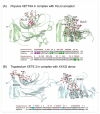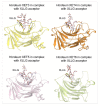Broad Specific Xyloglucan:Xyloglucosyl Transferases Are Formidable Players in the Re-Modelling of Plant Cell Wall Structures
- PMID: 35163576
- PMCID: PMC8836008
- DOI: 10.3390/ijms23031656
Broad Specific Xyloglucan:Xyloglucosyl Transferases Are Formidable Players in the Re-Modelling of Plant Cell Wall Structures
Abstract
Plant xyloglucan:xyloglucosyl transferases, known as xyloglucan endo-transglycosylases (XETs) are the key players that underlie plant cell wall dynamics and mechanics. These fundamental roles are central for the assembly and modifications of cell walls during embryogenesis, vegetative and reproductive growth, and adaptations to living environments under biotic and abiotic (environmental) stresses. XET enzymes (EC 2.4.1.207) have the β-sandwich architecture and the β-jelly-roll topology, and are classified in the glycoside hydrolase family 16 based on their evolutionary history. XET enzymes catalyse transglycosylation reactions with xyloglucan (XG)-derived and other than XG-derived donors and acceptors, and this poly-specificity originates from the structural plasticity and evolutionary diversification that has evolved through expansion and duplication. In phyletic groups, XETs form the gene families that are differentially expressed in organs and tissues in time- and space-dependent manners, and in response to environmental conditions. Here, we examine higher plant XET enzymes and dissect how their exclusively carbohydrate-linked transglycosylation catalytic function inter-connects complex plant cell wall components. Further, we discuss progress in technologies that advance the knowledge of plant cell walls and how this knowledge defines the roles of XETs. We construe that the broad specificity of the plant XETs underscores their roles in continuous cell wall restructuring and re-modelling.
Keywords: crystal structures; evolutionary history; glycoside hydrolase family 16; mechanism of catalysis; molecular modelling and dynamics; substrate binding; transglycosylation reactions.
Conflict of interest statement
The authors declare no conflict of interest.
Figures





Similar articles
-
Plant Xyloglucan Xyloglucosyl Transferases and the Cell Wall Structure: Subtle but Significant.Molecules. 2020 Nov 29;25(23):5619. doi: 10.3390/molecules25235619. Molecules. 2020. PMID: 33260399 Free PMC article. Review.
-
Another building block in the plant cell wall: Barley xyloglucan xyloglucosyl transferases link covalently xyloglucan and anionic oligosaccharides derived from pectin.Plant J. 2020 Nov;104(3):752-767. doi: 10.1111/tpj.14964. Epub 2020 Sep 19. Plant J. 2020. PMID: 32799357
-
Hemicellulose-remodelling transglycanase activities from charophytes: towards the evolution of the land-plant cell wall.Plant J. 2021 Oct;108(1):7-28. doi: 10.1111/tpj.15500. Epub 2021 Oct 9. Plant J. 2021. PMID: 34547150
-
Kinetic analysis using low-molecular mass xyloglucan oligosaccharides defines the catalytic mechanism of a Populus xyloglucan endotransglycosylase.Biochem J. 2006 Apr 1;395(1):99-106. doi: 10.1042/BJ20051396. Biochem J. 2006. PMID: 16356166 Free PMC article.
-
The XTH family of enzymes involved in xyloglucan endotransglucosylation and endohydrolysis: current perspectives and a new unifying nomenclature.Plant Cell Physiol. 2002 Dec;43(12):1421-35. doi: 10.1093/pcp/pcf171. Plant Cell Physiol. 2002. PMID: 12514239 Review.
Cited by
-
Nicotiana benthamiana Kunitz peptidase inhibitor-like protein involved in chloroplast-to-nucleus regulatory pathway in plant-virus interaction.Front Plant Sci. 2022 Nov 10;13:1041867. doi: 10.3389/fpls.2022.1041867. eCollection 2022. Front Plant Sci. 2022. PMID: 36438111 Free PMC article.
-
Signals and Their Perception for Remodelling, Adjustment and Repair of the Plant Cell Wall.Int J Mol Sci. 2023 Apr 18;24(8):7417. doi: 10.3390/ijms24087417. Int J Mol Sci. 2023. PMID: 37108585 Free PMC article. Review.
-
Harnessing Knowledge from Plant Functional Genomics and Multi-Omics for Genetic Improvement.Int J Mol Sci. 2023 Jun 19;24(12):10347. doi: 10.3390/ijms241210347. Int J Mol Sci. 2023. PMID: 37373493 Free PMC article.
-
Macroalgae Polysaccharides Enhance Brain Health by Mitigating Scopolamine-induced Oxidative Stress and Inflammation Via Nrf-2/TLR4/NF-kB Pathways.J Neuroimmune Pharmacol. 2025 Jul 22;20(1):74. doi: 10.1007/s11481-025-10230-5. J Neuroimmune Pharmacol. 2025. PMID: 40694170
-
A systems biology framework integrating cross-species transcriptomics and PPI networks for Xylella fastidiosa resistance gene identification.BMC Plant Biol. 2025 Aug 11;25(1):1062. doi: 10.1186/s12870-025-07102-8. BMC Plant Biol. 2025. PMID: 40790398 Free PMC article.
References
Publication types
MeSH terms
Substances
Grants and funding
LinkOut - more resources
Full Text Sources

